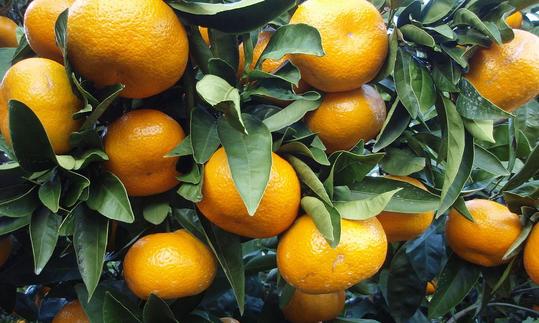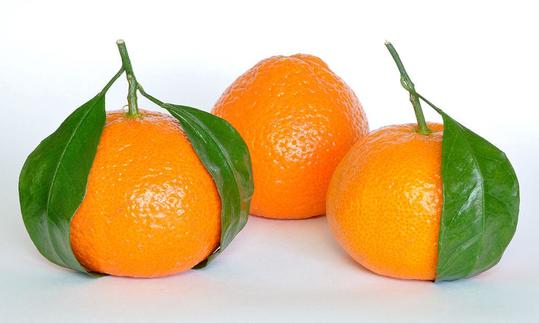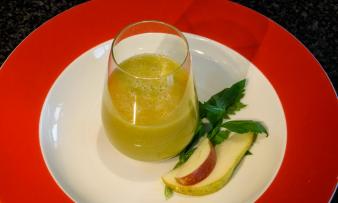Table of contents
The mandarin ( Citrus x reticulata ) is enjoyed primarily raw . In addition to its handy size, the fact that it is easy to peel is another reason why this citrus fruit is so popular as a snack among children.
Use in the kitchen
The intensely flavoured mandarin is easy to peel and, like the clementine , is one of the 'easy peelers'. 1 Although you don't eat the peel, you should always wash the mandarin before peeling it, as it can contain residues of pesticides and preservatives. To peel the mandarin, lightly prick the skin with a fingernail and peel off the skin of the whole mandarin. It is easier to peel than the orange and can be easily divided into the usually 9 segments. Depending on the variety, mandarins can contain seeds.
Mandarins are very popular fresh and raw, especially in the run-up to Christmas. Peeled and chopped, they are suitable in any muesli, including pea muesli . Raw mandarins go well in salads with tomatoes , avocados , carrots , apples or walnuts . Chicory is suitable for a bitter note in salads, or if you like something a little earthier, combined with beetroot . Mandarins are also suitable for fruit salads, vegan ice cream, vegan desserts, in juices, soft drinks and smoothies. Raw mandarins can be used with cooked rice to create a rice salad with spring onions ,corn and bell peppers .
Cooked mandarins are used in cakes and muffins or to make jams. Preserved mandarins in cans or jars are suitable for desserts and creams, but often have a very high proportion of added sugar.
Vegan recipe for tangerine shake
Ingredients (for 2 people): 4 ripe tangerines, half a lime , 300 g vegan soy yoghurt , 10 g oat flakes , ½ teaspoonvanilla powder .
Preparation: Peel the mandarins and squeeze the lime. Put the peeled mandarins and the lime juice in a high-performance blender or a mixing bowl. Add the vegan yoghurt and the oat flakes and mix well. Finally, refine the shake with vanilla powder as desired and mix again briefly. Tip: Serve with ice cubes in summer.
Vegan recipe for broccoli salad with tangerines
Ingredients (for 2 people): 600 g broccoli, raw , 50 g goji berries, dried , 50 ml vegetable stock , 1 tangerine, 1 avocado , 40 g walnuts , juice of ½ lemon, 1 tbsp rice vinegar , 1 tbsp rapeseed oil , salt andpepper .
Preparation: Chop and wash the broccoli and sauté in rapeseed oil, rice vinegar and vegetable stock. Peel and chop the mandarin and avocado, chop the nuts. After the broccoli has cooled, put all the ingredients in a bowl and season with lemon juice, salt and pepper.
Tea preparation
Mandarin tea is made from mandarin peels: cut the peels of two fresh, washed organic mandarins into strips, pour boiling water over them and let them steep for about ten minutes. If necessary, you can refine the tea with a cinnamon stick , especially in the winter season.
Vegan recipes with fresh mandarins can be found under the note: " Recipes that have the most of this ingredient ".
| Not only vegans or vegetarians should read this: Vegans often eat unhealthily. Avoidable nutritional mistakes . |
Purchasing - Storage
Fresh mandarin oranges can be purchased at major retailers such as Coop , Migros , Denner , Volg , Spar , Aldi , Lidl , Rewe , Edeka , Hofer , Billa etc., but also in organic supermarkets such as Denn's Biomarkt or Alnatura , as well as at the weekly market. The mandarin season in Spain (subtropics) usually begins in mid-September and lasts until the end of March . 2 The supply is also greatest here during the main harvest time in southern Europe (November - March), but depending on the supermarket you can buy mandarin oranges all year round. 3 Many supermarkets also sell canned mandarin oranges. The peel and fruit skins are removed using machines, hydrochloric acid and caustic soda. 4 In addition to sugar, they often contain other preservatives.
The availability of mandarins varies depending on the size of the store, catchment area, etc. If you are interested, click on our recorded food prices for the DA-CH countries (above under the ingredient image). There you will find current prices from various supermarkets and their price development.
Storage tips
The best place to store mandarins is in a cool place, such as a dark, cool pantry or cellar. To avoid the formation of mold, the mandarins should be placed in an air-permeable container (e.g. basket) and not touching each other. Because mandarins are sensitive to cold, the refrigerator is not the most suitable place for this citrus fruit. If stored at room temperature, the fruit should be consumed within a few days, otherwise it will dry out and lose its flavor. 5
Ingredients - Nutritional values - Calories
How many calories does a tangerine have? 100 g of raw tangerines contain 53 kcal. In addition to the water content of 85%, tangerines contain 10% carbohydrates, of which around 1.8% is fiber. Protein and fat are barely contained at 0.8% and 0.3% respectively. 6 Tangerines are good for losing weight because of their low calorie content and high water content.
The following nutrients and vitamins are contained in tangerines in significant quantities: The vitamin C content covers around 33% of the daily requirement at an intake of 27 mg/100g. This content can be compared to that ofraspberries or gooseberries . Real guava (228 mg/100g) and black currants (181 mg/100g) contain particularly high levels of vitamin C. The vitamin C content of tangerines can vary depending on the variety. 6
The folate (folic acid) content in mandarins is 16 µg/100 g. Raw pineapple has a comparable amount of folate at 18 µg/100 g. Raw spinach has significantly more folic acid at 194 µg/100 g and avocados at 81 µg/100 g. 6
The potassium content in mandarins covers 8% of the daily requirement at 166 mg/100 g, which can be compared with that of raw mango (168 mg/100 g) or lychee (171 mg/100 g). Of the fresh, raw fruits and vegetables, breadfruit contains a lot of potassium at 490 mg/100 g and lamb's lettuce at 459 mg/100 g. 6
The iron content in tangerines is negligible at 0.15 mg/100g.
The complete ingredients of mandarins, the coverage of the daily requirement and comparison values with other ingredients can be found in our nutrient tables. In the article Nutrients explained you will get a detailed insight into the topic.
Effects on health
The University of Western Ontario in Canada found in a study on mice that a substance contained in mandarins (nobiletin) had an effect against obesity, type 2 diabetes and arteriosclerosis. 7
There are studies on flavonoids in citrus fruits that, when combined with chemotherapy drugs, show promising effects against the growth of cancer cells. 8 Extracts of mandarin peels have also shown similar results. Further research is needed, but there is a possible effect of mandarin essential oil as a cancer-preventing food additive or anticancer agent. 9
The extract from tangerine peel is also said to have a strong antidiabetic effect. 10 Extracts from the tangerine tree leaves show an antioxidant, anti-inflammatory and analgesic effect. 11
Dangers - Intolerances - Side effects
In general, citrus fruit allergies are rare in Europe. There are only a few records of anaphylactic shocks due to the consumption of mandarins. 12 Cross-reactions between citrus fruits and grass pollen or pollen from apple trees do occur in adults and children with pollinosis. 13
The peel of conventionally grown citrus fruits has a rather high level of residues. The residues are mainly peel treatment agents (during growth or as a post-harvest treatment). 14
Certain pesticides (e.g. dichlorophenols) can promote the development of food allergies if consumed in excessive amounts. 15
Ecological footprint - animal welfare
When buying mandarins, pay attention to the country of origin. The shorter the transport route, the better the CO2 balance. Organically grown fruit is not treated with pesticides, which is why it contributes to environmental protection and the health of producers and consumers.
The ETH has determined that the consumption of citrus fruit in Switzerland has by far the largest CO 2 footprint for fruit and vegetables, at around 45,000 t CO 2 -eq per year. This is due, among other things, to the large quantities consumed. Internationally, in addition to transport (by ship and truck), water consumption, use of machinery and fertilizers (among other things) are causes of high CO 2 emissions in the production of citrus fruit. 16
Fertilizers and pesticides affect the composition of sugars, amino acids and organic acids in mandarins. 17
Worldwide occurrence - cultivation
The genetic center of mandarins is thought to be in northeast India (Meghalaya). 18 Mandarins are now cultivated in many tropical and subtropical regions, including the Mediterranean region, the coasts of Africa, Asia (including the Arabian Peninsula, India, southern China) and Oceania (including the coasts of Australia and New Zealand). Among citrus fruits, mandarin production accounts for 22-25% worldwide. 19
Cultivation - Harvest
It is quite possible to grow the mandarin as a small tree or bush in the garden, on the balcony or on the terrace. The plant grows much bushier and lower than other citrus species such as lemons or oranges . The height of a mandarin tree is up to about two meters, making it ideal as a pot plant. If well cared for, the plant will flower several times a year. Like most citrus fruits, the mandarin is self-pollinating, meaning it does not need insects for pollination. Depending on the temperature, it takes four to five months from flowering to fruit ripening. Like all citrus species, mandarins love full sun. 20
The mandarin tree has evergreen, shiny and lancet-shaped leaves that are renewed approximately every three years. When they first sprout, they are light green and later turn darker. 20 If the mandarin tree leaves curl up, this means there is a lack of water.
In tropical regions, mandarins are not orange, but greenish-yellow. However, the fact that they are unripe does not mean that they are not juicy or aromatic. The reason for the orange color is not ripeness, but the cold. The low temperatures break down the chlorophyll that gives the fruit its green color. Then the orange carotenoids appear. In the tropics, the fruits also ripen, but remain greenish due to the lack of cold. Tropical mandarins that can be bought in the store are therefore subsequently treated with cold or ethylene to achieve the same effect. 21
Possibility of confusion
The mandarin looks very similar to the clementine . Both belong to the mandarin family with the following distinguishing features: The skin of the mandarin is thicker and easier to peel than that of the clementine. The latter is smaller, sweeter and has fewer seeds. The mandarin is more aromatic. The clementine is a hybrid of oranges and mandarins. 22 The mandarin normally has 9 segments and the clementine 8-12.
Further information
The mandarin belongs to the rue family, more precisely to the genus Citrus, and is a berry fruit. Within the citrus fruits, Citrus reticulata , Citrus medica (citron) and Citrus grandis (grapefruit) are the three most important basic species, from which most of the other known hybrids have been bred. 22 The mandarin-like plants are a large, variable group. The plants differ in their habitus, the fruits in their shape and taste. There are many varieties and also random mutations, such as the satsumas, tangerines and minneola, which we describe in more detail in the clementines section .
Alternative names
In English, the mandarin is known as mandarine, mandarin oranges, or tangerine. The latter is also considered a synonym for both species, the mandarin and the tangerine.
Chinese orange is a name that crops up again and again as a common name. In Bengali (the language of India and Bangladesh) mandarin is called Kamala lebu.
Other uses
The peel of the mandarin is also used in the production of perfumes. Essential mandarin oil is obtained by cold pressing the peel. Two to three kilograms of citrus fruit peel are needed to produce one milliliter of mandarin oil.











Comments